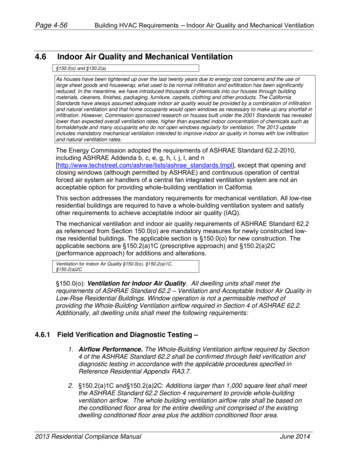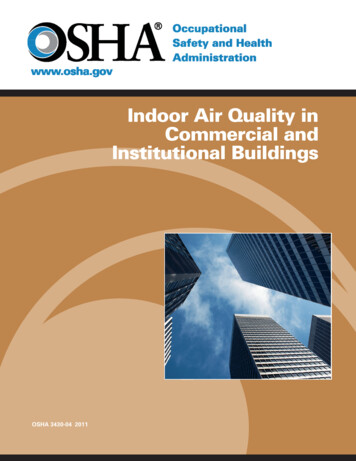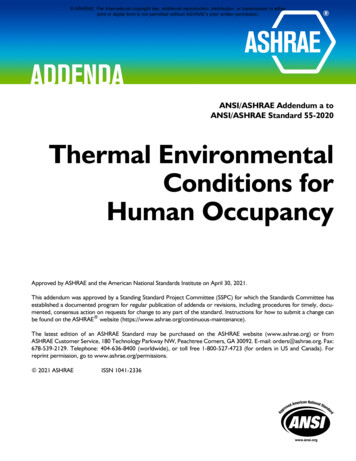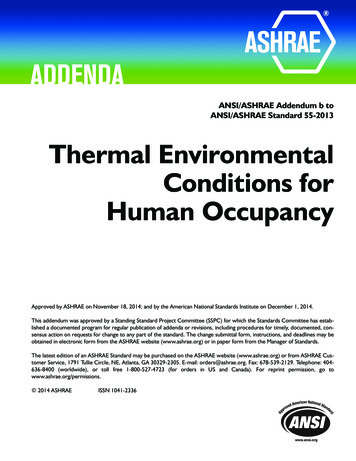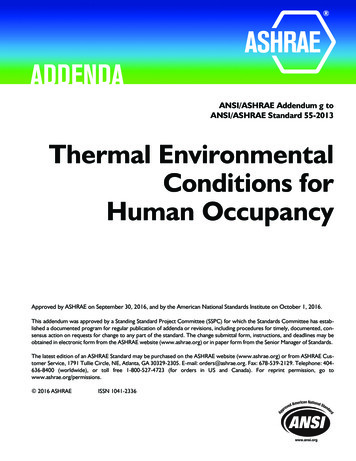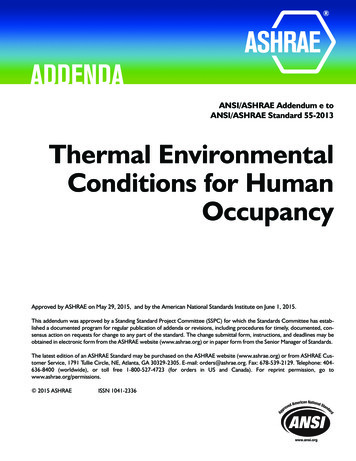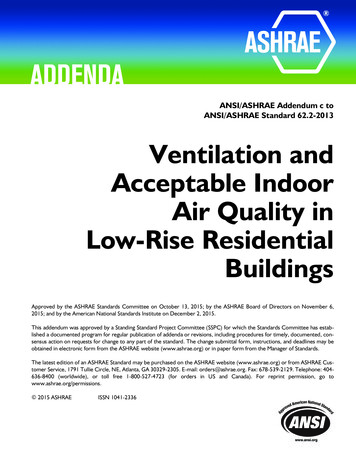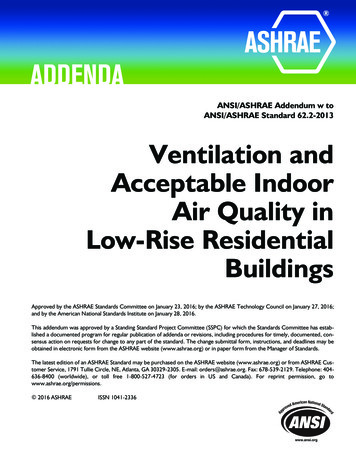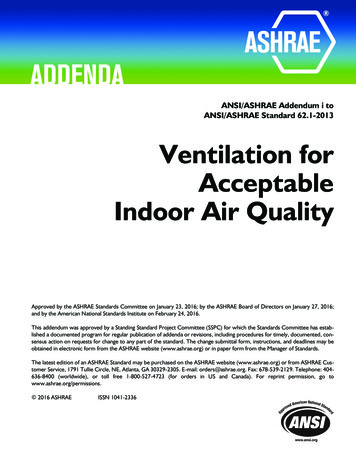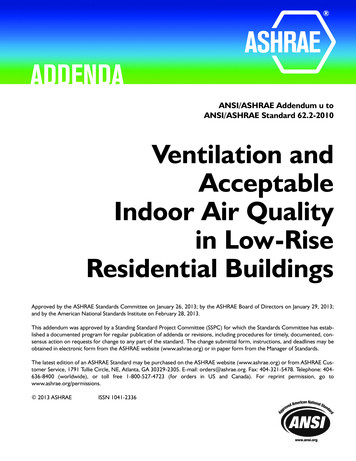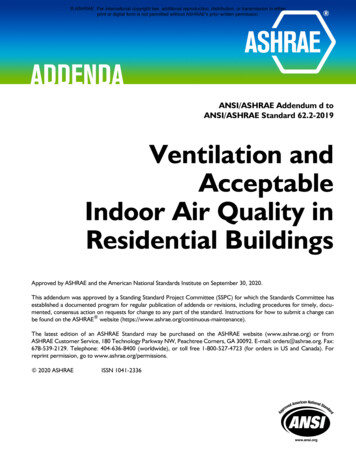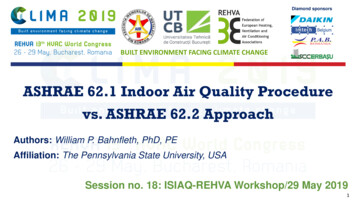
Transcription
Diamond sponsorsBUILT ENVIRONMENT FACING CLIMATE CHANGEASHRAE 62.1 Indoor Air Quality Procedurevs. ASHRAE 62.2 ApproachAuthors: William P. Bahnfleth, PhD, PEAffiliation: The Pennsylvania State University, USASession no. 18: ISIAQ-REHVA Workshop/29 May 20191
Outline Introduction – ASHRAE Ventilation Standards ASHRAE Standard 62.1– Current Indoor Air Quality Procedure (62.1-2016)– Exhaust requirements– Addendum 62.1-2016 aa regarding Indoor Air Quality Procedure ASHRAE Standard 62.2-2016 ventilation requirement ConclusionCLIMA 2019 - Built Environment Facing Climate Change2
Introduction ASHRAE standards– Consensus standards developed by balanced committees– Development process governed by ANSI procedures – public review, responses tocomments, change proposals– ASHRAE approves title, purpose and scope, not contents History– 1973 – First Standard 62 published– 2003 – 62 becomes 62.1 for non-residential buildings with first publication of 62.2for residential buildings– Additional standards deal with specialized environments, e.g., healthcare facilities(Standard 170)CLIMA 2019 - Built Environment Facing Climate Change3
Introduction Both 62.1 and 62.2 are perceived air quality standards with similar definitions ofacceptable indoor air quality ASHRAE 62.1-2016:(A)ir in which there are no known contaminants at harmful concentrations asdetermined by cognizant authorities and with which a substantial majority(80% or more) of the people exposed do not express dissatisfaction ASHRAE 62.2-2016(A)ir toward which a substantial majority of occupants express no dissatisfactionwith respect to odor and sensory irritation and in which there are not likely to becontaminants at concentrations that are known to pose a health riskCLIMA 2019 - Built Environment Facing Climate Change4
ASHRAE Standard 62.1 Compliance paths– Ventilation Rate Procedure (VRP, prescriptive)– Indoor Air Quality Procedure (IAQP, performance)– Natural Ventilation Procedure (prescriptive) Major changes have been proposed to IAQP in Addendumaa to standard 62.1-2016CLIMA 2019 - Built Environment Facing Climate Change5
ASHRAE 62.1-2016 IAQP (Section 6.3) Identify contaminants of concern, safe limits, indoor/outdoor sources and emissionrates – use sum of concentration/safe limit 1 for mixtures Determine design level of acceptability (%) – may be adapted and/or unadapted Do mass balance calculations to determine required ventilation rate – includingeffect of air cleaners Required ventilation rate is greater of mass balance calculation and either– Post-occupancy subjective evaluation, or– Rate required for a similar zone for which subjective evaluation has been done May use VRP to determine minimum outside air and IAQP to determine additionaloutside air required to meet criteria for specific contaminantsCLIMA 2019 - Built Environment Facing Climate Change6
ASHRAE 62.1-2016 ExhaustRequirements (Section 6.5) Exhaust is treated somewhat analogously to outside air Requirements maybe be met by– Complying with flows in table 6.5 (prescriptive)– As with IAQP, identify contaminants of concern, safe concentrations, sources,source strengths and automatically control to achieve themCLIMA 2019 - Built Environment Facing Climate Change7
Addendum aa to ASHRAE Standard62.1-2016 Addendum aa is a major proposed revision to the IAQP Three public review drafts issued, latest in Feb 2019 Addresses perceived weakness in existing IAQP– Identifying contaminants of concern– Identifying safe limits and periods of exposure– Specifying percentage satisfied Approach– Design compounds and PM2.5 limits specified– Specific mixture for which mixture compliance is needed are identified– Eight hour time period for exposure assessment– 80% acceptable criterion specifiedCLIMA 2019 - Built Environment Facing Climate Change8
Design Compounds/PM2.5MixturesNote – Information on this slide taken from First Public Review Draft –addendum may not be approved and if approved final content may differCLIMA 2019 - Built Environment Facing Climate Change9
ASHRAE Standard 62.2 Ventilation requirements are prescriptive– Number of bedrooms– Floor areaQ tot [l/s] 0.15[ l / s m 2 ]A floor [m 2 ] 3.5[ l / s br ](N br 1) Can take credit for infiltration if leakage has beenmeasured Can adjust for differences in assumed occupancy, timeaverage occupancy Currently no performance pathCLIMA 2019 - Built Environment Facing Climate Change10
CLIMA 2019 - Built Environment Facing Climate Change11
Conculsion ASHRAE Standard 62.1 for non-residential buildings has had a performance path formany years, but perception of most designers has been that it is difficult and risky touse. 62.1 IAQP is undergoing a major update, but it has been contentious, mainlybecause of views of committee members and other interested parties about aircleaners ASHRAE Standard 62.2 takes a prescriptive approach like 62.1 although somewhatsimplified. There is substantial interest in expanding the performance approach but concernabout the knowledge base available to support itCLIMA 2019 - Built Environment Facing Climate Change12
Thank you!wbahnfleth@psu.eduCLIMA 2019 - Built Environment Facing Climate Change13
ASHRAE Standard 62.1 for non-residential buildings has had a performance path for many years, but perception of most designers has been that it is difficult and risky to use. 62.1 IAQP is undergoing a major update, but it has been contentious, mainly because of views of committee members and other interested parties about air cleaners ASHRAE Standard 62.2 takes a prescriptive approach like 62 .
